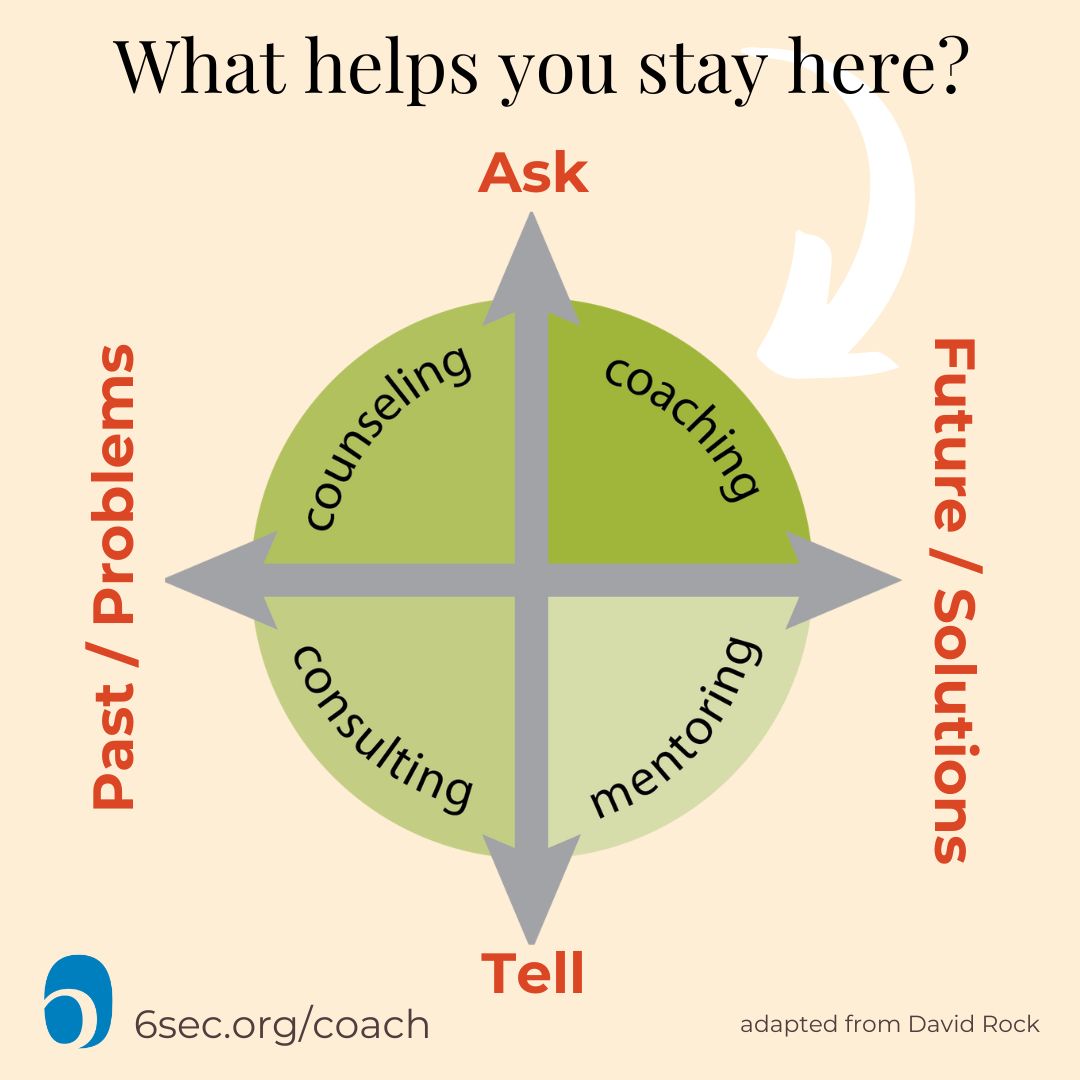The Wrong Time To Coach: What is the Most Effective Approach for Your Next 1:1? 🌱
Coaching is transformative, and one of the most effective ways to build capacity for growth, alignment, and engagement. Many organizations lose the value of coaching because they call every one-to-one (1:1) “coaching.” But just as bad would be to try to make every 1:1 into a coaching session.
The first step is to understand what coaching is and isn’t, and how that applies to your 1:1s.
What is coaching, and how does it apply to a managerial 1:1?
Usually when I explain coaching to a potential client, I say, “As a coach, my job is to stand shoulder-to-shoulder with you as a partner, supporting you to work on your goals.” A more formal definition of coaching from the International Coaching Federation: Partnering with clients in a thought-provoking and creative process that inspires them to maximize their personal and professional potential.
From both definitions, we can see the importance of partnership in support of the client’s goals. Coaching is also about unleashing energy – fueling motivation from within – and that’s strengthened by having more emotional intelligence skills as well as coaching skills.
I also like the model to the right, adapted from David Rock, which defines coaching as asking questions about the solutions and the future.
Using this framework, we can consider a coach-approach to a 1:1:
You’ll mostly be asking questions, and not telling.
You’ll mostly be focusing on solutions and the future, vs digging into what went wrong.

Imagine a typical managerial 1:1 around a performance issue (thanks to Ben Kirby for this example):
Manager: You didn’t hit the numbers we agreed to [tell]. What went wrong? [problem]
Team member gives some explanation.
Manager: Whatever, the point is, this can’t continue [tell]. What I want you to do is… [tell]
What if the manager flipped to ASK and FUTURE quadrants?
Manager: How is this quarter going?
Team member says it’s not great.
Manager: What would make that better [ask, future] and how can I help?
Team member has some challenging thinking to do!
That small shift puts the ownership on the team member, and moves the manager into a support role. The whole conversation isn’t in the “coach quadrant” but most of it is. This leads the team member to have much less defensiveness, and much more ownership. It also means they’re far more likely to actually follow through.
When is coaching the wrong approach?
That shift in ownership requires a certain readiness and capability.
Some questions:
What’s the timeline? If there’s genuine urgency (not just fake-urgency-trying-to-motivate), then telling might be faster.
What’s the level of flexibility? If you can’t or won’t accept alternate solutions or adapt, then don’t ask your team member to come up with their own solutions.
What’s their level of experience and competence? If someone is brand new and doesn’t have the background skills and knowledge, then mentoring might be more effective.
What’s the trust level? If you don’t trust one another, it’s unlikely that you’ll get very honest answers with a coach-approach. That said, it might be the best way to build trust.
Finally, in the emotional intelligence coaching certification, we focus extensively on setting effective coaching agreements. While a manager-as-coach doesn’t follow quite the same process, the underlying principle is the same: If there’s no agreement, it’s not coaching.
So, a crucial question for managers considering a coach-approach: Does your team member agree to be coached? Remember, coaching is a mutual partnership, and without agreement, you don’t have that essential foundation.
This article is from the 🌱 Emotional Intelligence Coach Newsletter
Click here & choose the newsletters that will help you practice and grow emotional intelligence
Shared Ownership: Coaching is a Force Multiplier
One of the biggest benefits of coaching is a shift in the power dynamic. When you take a coach-approach, you shift your stance to stand side-by-side. You put down (at least much of) your positional power. That empowers the person you’re talking with.
That can be scary for managers (and teachers, and parents, and coaches) used to being fully-in-charge, and getting respect due to title and position. Moving out of the pattern of “being the one who knows” is a real risk. On the other hand, if people still listen to you when you’re using the coach-approach, it means they’re following you because you’re worth following.
Whether you’re a professional coach, or contemplating earning certification as a professional emotional intelligence coach, or you’re someone who uses coaching techniques to support others: of course these questions apply to us first.
While there are many coach certifications out there, the Emotional Intelligence Coach Certification stands out for its blend of practicality and depth, extensive practice, and tons of faculty support so you become a highly effective coach. That’s recognized by the highest-level accreditation from International Coaching Federation plus academic credit for almost 1/3 of an MBA or MA!
For more on EQ and Coaching 🌱, I recommend:
Why EQ + Coaching?
Neuroscience ‘tricks’ for change
- What Are Emotions? Understanding the Science and Meaning Behind How We Feel - October 25, 2025
- Resilience in Recessionary Times: Emotional Intelligence Strategies to Stay Grounded in Escalating Challenge - October 5, 2025
- The Emotional Recession: Trillions of Dollars, Trillions of Heavy Days - September 8, 2025

